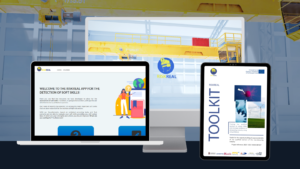Success and proficiency in the working environment does not depend only from technical competencies of workers. Non-technical skills (also called “soft” skills or “transversal”), in fact, play a major role in the productivity of a worker, in particular if working in a team, not neglecting either the impact they can have on their safety at work, especially in some relatively risky working fields.
The growing importance of soft skills in labour market:
Some might argue that soft skills are needed only by people covering managerial roles but it would be absolutely erroneous to think this way.
A research conducted in 2021 by an international group of companies in the framework of an Erasmus+ project (SKILL) studied how important are soft skills in the labour market for technical companies:
Of the participants in all 5 countries involved (Malta, Italy, Greece, Cyprus, Slovenia) stated that the skills that are most required in a professional domain are: interpersonal skills and social skills, adaptability, take initiatives, willingness to learn, communication and linguistic abilities, self-awareness, ability to be responsible, organizational skills.
None of these skills is a strictly technical one and yet they are deemed as the most important for even very technical job roles, notwithstanding its hierarchical level within a company.

Interactive scenarios learning
The problem with non-technical skills is that they are somehow linked with the personality and character of an individual, they cannot really be learned from books or through a merely theoretical approach. They are shaped, learnt and understood by interacting with others, by finding themselves in specific and challenging situations and through experience.
Yet, companies cannot be expected to wait until their employees have faced enough of these situations and developed “naturally” their soft skills. This is when e-learning (in particular in its most interactive version, the one based on learning scenarios) comes into play.
Modern e-learning platforms allow for the creation of rich, immersive and realistic learning modules, turning topics related with reaction to certain external situations and factors and/or the interaction with other people (colleagues, managers, clients etc.) into interactive, scenario-based learning activities. The reasons of the success of this approach are:
The right scene makes everything more impactful: learners can be presented with a scenario in which they need to apply specific soft skills to solve a problem. Complex and detailed scenarios requiring a combination of soft skills could be devised too. The scenarios can be presented in text, video or audio format, for example, even though a combination of these elements is for sure the best working solution.
Responses to the situations represented in the scenarios can be provided by learners via a various set of options but, usually, the more advisable one is using multiple-choice answers. Users might receive or not an immediate feedback after they do their choice. In this way their behaviours is immediately steered towards the correct practices. Extra tips or useful piece of information might be provided to them too. If they choose the wrong answer, they can be explained why it’s wrong, and steer them towards making a better choice. However, the provision of an immediate feedback prevents the scenarios from being used to assess their improvements over time (as they already know which is the right answers to the various issues that are presented to them!).

The effectiveness of this approach is due to the fact that it encourages employees to imagine real-life situations. By responding to realistic scenarios, they learn by doing. Practicing soft skills this way in a low-pressure e-learning environment helps learners internalise useful skills and establish good habits.
The presented scenarios should, however, be realistic and apply to the work situation of the employees engaged with them. Ideally, there should be details evoking the real-life workplace or environment of learners. These methods benefit from the fact that they represent an authentic (even if simulated) context:
Students play the game by applying knowledge and developing competencies which creates a parallel between the perspectives and solutions of case studies in situations of real life (Jonassen, 2011).
This learning method offers a wide variety of options in terms of solutions, as there is usually no one single solution: similarly, to real-life contexts, discussion and collaboration are required to find the best option (Lyons& Bandura, 2020).
Written by: Andrea Puglisi – Project Manager
from IPPO Engineering
REFERENCES:
Jonassen, D. (2011). Supporting Problem Solving in PBL. Interdisciplinary Journal of Problem-Based Learning, 5(2), 9–27. https://doi.org/10.7771/1541-5015.1256
Lyons, P., & Bandura, R. P. (2020). Skills needs, integrative pedagogy and case-based instruction. Journal of Workplace Learning, 1, 1–15. https://doi.org/10.1108/JWL-12-2019-0140





